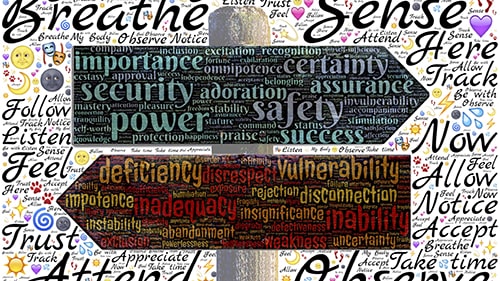self-regulation practices

in this program
- mindfulness
- you can change how you feel
- "Window of tolerance"
- practices
when you hear yourself saying: “i’m not happy because you…” “you make me feel like…,” you may want to recognize that you need to practice self-regulation. similarly, when you notice that your partner despairs, suddenly goes mute, or recoils from intimacy, you may want to ask yourself whether you contributed to their mood. we cannot be blamed for what another feels, but our actions, or non-actions, can be difficult for others.
as long as we blame, play the victim, manipulate, and coerce, there can only be pain. the immature mind oversimplifies causality and sees the cause of feelings as being outside ourselves. since not everyone will have the same reaction to the same circumstances, it is clear that the emotion comes from within us. it is created through how we interpret our experience, and if this interpretation is marred with unconsciousness, reaction, distortions of thought and emotion, or traumatized memories, we need to apply self-regulation to counteract our distorted interpretations.
there is a beautiful Buddhist teaching story that tells of a master and student and their balancing act. the master would balance a bamboo pole on his shoulders, and the student would sensitively climb to the top and perform some balancing postures. when they were quite accomplished and making money through their street-act, the master said to his student. “we’ve found a good way to support ourselves, and need only remember to focus on one another, in order to increase our skill.” the student had an astonishing response. “no,” she said, “we each only need to focus on ourselves and our balance, and the act will grow in skillfulness.” the student understood the essence, and surpassed her master.
unconscious living
the Thought triangle from Cognitive Behavioral Therapy (CBT) below gives us a very good sense of what happens when we live unconsciously, in other words, when we’re not mindful, reflective, or empathic. our opinions don’t change, but harden instead. our habits become more and more self-sabotaging. our thought is filled with cognitive distortions. our emotions and feelings are extreme and reactive. actions are avoidant, impulsive, or controlling. no adaptation is occurring within the organism, and it becomes harder to adjust to a changing world. we feel this as a sense of defeat.

non-judgmental attention in current experience
the opposite of the state of unconsciousness is that of mindfulness or presence. this state is optimal because we are not seeking a particular outcome, nor trying to get rid of anything, including discomfort or thought. in essence, we are attentive to what is taking place in feeling, thought, and the senses. we are looking into thought and feeling. this attention has the quality of being aware of itself, so that we feel aware of what is happening in our awareness. at the same time, we are aware of the process of awareness, or perception. both inside and outside are included.

a true friend stays present with you in times of sorrow. she listens deeply, feels what you feel, but never tries to fix or change you. she knows you are not broken.
be a true friend to yourself.

Jeff Foster

mindfulness in self-regulation

without reflection, we go blindly on our way, creating more unintended consequences, and failing to achieve anything useful.

Meg Wheatly
our increasing knowledge of self, combined with the attention of mindfulness, allows us to notice our biases and projections, and be aware of our over-compensation. reflective empathy allows us to listen receptively to ourselves and the other. we’re aware of the mind-heart’s ability to be open and to understand. we’re holding emotion, in self and other, and staying aware of emotions and needs. as a result, we feel grounded, present, and deeply aware of relating with self, other, and the environment.
mood and emotion can change from moment to moment. feel for a moment into your current mood. can you name it? now imagine one of your simple pleasures, and the experience of such. has the emotion changed? self-regulation means employing strategies to influence the types of emotion that arise, how long they last, and how they’re interpreted and expressed. mindful individuals report less negative emotion, as the mind is prepared to meet experience, and regulate it when necessary.

you can change how you feel

attitude is a choice. happiness is a choice. optimism is a choice. kindness is a choice. giving is a choice. respect is a choice. whatever choice you make, makes you. choose wisely.

Roy T. Bennett

as we saw in the self-awareness program, Lisa Barrett’s theory of constructed emotions changed how we understand emotion. we now know that emotions are not hard-wired, but fluid, like the neocortex itself. we construct new emotions every time we experience them. based on what we like or feel drawn to, the way we interpret or understand our emotion, past experiences, and our emotional goals, we can slowly move terror to acceptance, and even to joy. we can befriend what we feel, and integrate, rather than react. we can acquire a taste for emotions in the same way that we can acquire a taste for a type of food: through engagement with it.
we’re typically scared of painful emotions, like anger, jealousy, pride, anxiety, or doubt. when we meet them on their terms, we realize that they are just emotions, and need not be feared. it can take a while to cool the amygdala (fear center in the brain) down, to understand our reactions, and to learn different responses. every “new” experience becomes data for future responses and constructions. the love we feel today has been constructed by all the previous loves we have felt.
Dan Siegel’s Window of tolerance
self-regulation is necessary for simple difficulties in our behavior, but also for deeply seated and possibly traumatized feelings. the only way in which you can know where you are, would be the intensity of the emotion. when mind perceives a threat (whether an actual threat is present or not) it goes into one of two states. the first is called hypo-arousal, which describes a mind that is not able to process what is happening, and as a result the person feels frozen, numb, or dissociated. in this state no learning or adaptation can take place. the second state is called hyper-arousal, and this is where the fight/flight reaction manifests. mind is racing, and the person feels shocked and out of control of their emotions. this state also prohibits learning or adaptation. the place from which the mind can adapt and learn new behavior is within the window of tolerance.
we can be wise in choosing what to work with, and which situations to avoid. the optimal approach is to begin practicing in easier circumstances, and gradually take the practice into more challenging areas. gradually we expand our capacity, until we can include what was avoided before.

grounding overwhelm

even when we can’t control the situation around us, we always can choose where we’re directing our attention.

Liz Stanley

in situations of overwhelm, whenever possible, try to leave the room for a few minutes to gather yourself.
sitting or standing, with the eyes gently closed or cast down, just take a deep breath. and another one. notice how the body releases some tight muscles. if you take another breath, you may be blessed with the releasing of a knot. on every round of breathing, simply allow the body to settle as much as it desires, and notice (feel) this change.
when you feel more grounded and present, think of an animal, person, or place that makes you feel safe. imagine, right now, the person or animal being at your side, gently and supportively touching you. or see yourself in the surroundings of your safe space. use your imagination to release more deeply into the experience. focus on all your senses: what you can see, hear, feel, smell, and even taste, to enhance the visualization. let yourself learn or gain support from the person, animal, or situation. let the imagination guide.
breathing naturally, let yourself experience the safety and peacefulness as long as it lasts. gently notice the space around you by opening your eyes or lifting your gaze. if you’re going back into a difficult situation, do it with some resolve. "... is what i want to say," or "...is what i’m going to do."
when your practice becomes strong, mindfulness itself is enough to ground strong emotion, but until then you may want to use the above as a way of grounding yourself and feeling more able to choose your actions or make decisions. if not possible in the situation, you can do it later. try to enter the situation again fully, and the let imagination take over. you want to find those aspects that are natural to you and that can support you in the difficult situation.
practices
when your practice becomes strong, mindfulness itself is enough to ground strong emotion, but until then you may want to use the above as a way of grounding yourself and feeling more able to choose your actions or make decisions. if not possible in the situation, you can do it later. try to enter the situation again fully, and the let imagination take over. you want to find those aspects that are natural to you and that can support you in the difficult situation.
- acknowledge and own difficulties
- accept responsibility
- lean into difficulty
- work with mood
- become conscious of habitual thought
- self-regulation in daily life.

acknowledge and own difficulties
look back over day and find events where you felt reactive, or where you noticed yourself reacting.
- what did you experience?
- what is the central emotion?
- what is this reaction trying to protect you from?
(what will happen if you don’t react?) - is this protection necessary, and why?
(are those assumptions?) - what are the triggers?
- what are your emotional goals?
(what different outcome do you want?) - what is the step you will take next, to experiment with finding a different way?

be on your own side. approach the problem like you would for a friend. clarify the experience, and ascertain what you want to work with, or change. look more deeply into action, feeling, and thought. see what is really happening, without interpreting things too much. be honest with yourself. be specific, realistic, and listen to the situation and yourself. we cannot blame the other for our emotion, and it remains our responsibility to deal with our difficulties, difficulties that usually also cause pain for others. be willing to witness your emotion, and learn to hold it. the more we adapt to the emotion, the less we will see it as a problem.
some examples:
behavior i'd like to stop/alter
- insulting (judging)
- screaming at others.
typically accomodating emotions
- frustration
- exhaustion
- rage
- irritation.
emotional triggers
- frustrated when i see how behind your work is
- scared when i read the news
- lonely when my partner does not return affection.
we all know what it feels like to act defensively or with a closed heart. we all fear loss, loneliness, meaninglessness, and the bitter pain of grief. we fear feeling painful or even uncomfortable feelings, especially when we feel trapped in them. we’d often rather lie to ourselves or another than hear a painful truth. we’d often rather keep busy and push feelings away than sit still, giving them time and processing them. in fact, most of us are not even aware of how and when we push feelings away. it has already become our habit. no wonder then that we have so little skill in dealing with painful feelings, banished as they are.
accept responsibility
and then one day, maybe because we’re simply too tired to defend/blame anymore, and we’re exhausted from running away, we simply feel the feeling. cautiously, we notice where it lives in the body, how it acts, what sensations are created, what happens with the feeling over time, and what it means to simply be with a feeling. we come to know what soothes it, and what makes it hurt even more. we’ve accepted responsibility for this emotion and learned from it, and that was all it ever wanted from us.

when we do not suffer who we are, others must suffer it for us.

Gunilla Norris

change will not come if we wait for some other person, or if we wait for some other time. we are the ones we’ve been waiting for. we are the change that we seek.

Barack Obama

six healthy ways of relating with emotion
- accepting the emotional experience and engaging with it
- identifying and labelling the emotion
- feeling into the emotion and how it behaves
- realizing the impermanence of emotion
- inquiring and investigating (triggers, coping mechanisms)
- letting go of the need to control the emotion and its experience.
"what would happen...?"

what would happen if you removed the word ‘anxious’ and just paid attention to these flickering sensations in the belly? what would happen if you took away the concept ’lonely,’ and simply became fascinated with this heavy feeling in the heart area? what would happen if you deleted the image ‘sick,’ or ‘broken,’ or ‘bad,’ and just got curious about the tightness in the throat, pressure in the head, the ache in the shoulders? what would happen if you stopped looking for solutions, and checked to see if there was actually a problem here? come out of the exhausting storyline, friend. it’s not true. it was never true. commit sacred awareness to a single living moment. come closer to yourself, Now. bring warmth to the tender places inside. infuse sensation with the light of attention. it’s never as bad as you think.

Jeff Foster
lean into difficulty
the greatest enemy of self-regulation is avoidance. what we avoid cannot grow. what we fail to pay attention to becomes unconscious. we have so many ways of running away from problems. we do it by ignoring, distracting, planning, restlessness, self-medicating, substance abuse, defensive speech and behavior... and each of those can be the key to showing us what is really going on. every time we ignore a problem, it gains ground. everything we avoid is a skill we may need somewhere. once the avoidance has taken root, the problem tends to increase, along with our non-agency. we’d often rather fret than act, rather distract ourselves than be vulnerable. it takes courage to face our problems. it also builds esteem, respect, and self-worth.
okay, this is where i am. (this) has happened. i’m responsible for (the situation, or part of it). leaning in, engaging with it, even if uncomfortable, will lead to either a solution and more knowledge, or the peace of mind that i’ve done everything i could. it is scary and vulnerable, and also powerful and liberating; standing emotionally open-hearted in your circumstance, bearing it with an accepting sense of responsibility. knowing that these are pieces of your life, which you’ll run into again and again. every time you this happens you can increase your skill and integration. it is an opportunity as much as a difficulty.

if your emotional abilities aren’t in hand, if you don’t have self-awareness, if you are not able to manage your distressing emotions, if you can’t have empathy and effective relationships, then no matter how smart you are, you are not going to get far.

Daniel Goldman

work with moods
no one is immune from a bad day, and for some of us, moods can be a destructive aspect of our life. for this reason, depression is considered to be a mood disorder. in psychology, moods are affective states that give rise to patterned thought-feelings. they are less intense than emotions or feelings, but also longer lasting. they are typically described as having a positive or negative valence (intrinsic value of “goodness,” or “badness.”). this valence is based on the rejection or acceptance of facts, possibility, and certainty. Ontological Coaching provides a very practical model in terms of understanding moods. three primary moods, based on the three intelligences (action, thought, and feeling), can be discerned:
action intelligence moods
| valence | mood | underlying beliefs | predispositions | bodily expression |
|---|---|---|---|---|
| negative | resentment (opposing facts) |
|
|
|
| positive | acceptance (accepting facts) |
|
|
|
thought intelligence moods
| valence | mood | underlying beliefs | predispositions | bodily expression |
|---|---|---|---|---|
| negative | resignation (opposing possibility) |
|
|
|
| positive | engagement (accepting possibility) |
|
|
|
feeling intelligence moods
| valence | mood | underlying beliefs | predispositions | bodily expression |
|---|---|---|---|---|
| negative | anxiety (opposing uncertainty) |
|
|
|
| positive | curiosity (accepting uncertainty) |
|
|
|
adapted from Ontological Coaching: Newfield Institute
the mood predisposes the psyche to triggering in the form of irritation, conflict, and reaction. when in a mood we don’t like, we reflexively want to get away from it. but to ignore a mood is to drive it deeper. acknowledge what you’re feeling. it is often a relief simply to know. discomfort tells us that a boundary has been crossed. it is the alert telling you that you need to assess the situation. look for the roots of what you’re feeling now. what is your current relationship with self? if the mood has been going on for a long time, consider the possibility that it has become a habit, a learned response, or an affect disorder. decide what you want to do with the mood. what are the actions you will take to help yourself out of destructive moods?
coping strategies for moods
there are no universal coping mechanisms for bad moods, but some of the suggested strategies can be very helpful when applied within your context.
- create emotional distance
- push through
- take care of something, or someone
- do what feels good
- take a walk in nature
- listen to internal messengers.

create emotional distance
reflect on why you feel so uncomfortable, and see whether you have any strategies for engaging the mood. objectivity also means looking into thought. when we speak unreflectively, we may only give vague descriptions of what ails us. it is helpful to question ourselves in order to see more deeply into the problem:
| surface message | deeper message |
|---|---|
|
|
three questions we can ask in terms of overwhelming thought:
- is it true? (am i assuming things?, would others see it this way too?)
- what are my underlying beliefs? (what do i believe in terms of this thought?)
- how does this thought make me feel? (notice the story that you tell yourself about what is happening).
push through
when we notice the signs for a particular mood, and also know the signs for its opposite, it becomes possible to change our behavior, posture, and level of energy. when this is done with mindfulness and noticing the relief, or the change from one state to another, it can be very helpful.
take care of something, or someone
by focusing on someone/thing else, we can quite easily change our mood. focusing on another will trigger a different posture, outlook, and attitude. the changes in thought, speech, and action are observable.
do what feels good
sense inwardly what you are most drawn to, from a range of activities, and change what you’re focusing on. do anything that you know is uplifting for you. this can be anything from a yoga class to watching series (in moderation). some people find deep relief by working in their garden or cooking a meal.
process feelings
"why am i feeling this way?" "what was the trigger?" "what would be a different response?" "how is this mood beneficial?" "how is the mood a defense, and against what?"
self-soothe, and accept that some days are just low. translate the feeling into an action. consider your values to help in translating. for example: i notice exhaustion, and then choose to move slower and do less.
take a walk in nature
look around, look up, listen, smell. let beauty reach you. wake up to the sensate information, rather than your thoughts. let go of the problem and enjoy the experience. you can return to it later. see the stillness and acceptance of nature. be aware of her engagement with you.
listen to internal messengers
reat strong emotion as a puzzle, not a problem. we’re not thinking of the emotion as something to fix, but rather something to explore, get to know, and adapt to. we’re curious about how it works, and what function it may have in our life. how it may contribute to some growth. what thoughts, feelings and actions are behind it, or the result of it? what are you scared of?
you are not responsible for what you feel, or what another feels. emotions are not under our direct control. we are responsible for our actions, or how we choose to think. when we can clarify what it is we need to accept responsibility for, it becomes easier to relate more effectively.
become conscious of habitual thought

if you are distressed by anything external, the pain is not due to the thing itself, but to your estimate of it; and this you have the power to revoke at any moment.

Marcus Aurelius

our constant unconscious thinking creates the lens through which we see reality, and when we are not aware of this, we tend to believe our thoughts, as if they represent reality. we’re also unaware of the filtering of our personality, which unconsciously focuses on specific information and screens out other information. realizing this means using the knowledge consciously.
for example: i need to create a routine, but my lazy and comfortable side does not want to budge. okay, so i’m aware of it. that’s good, but not enough. to take it deeper, i remind myself at different points of the day to reflect on that necessary routine, taking a moment to ask whether what i’m doing right now fits into my goal.
- if so, i’ve stumbled upon something i want to keep in the routine.
- if not, this is a time consumer that i will have to part ways with. that’s the next step. now i’ll have to sharpen attention (discipline) and deal with feelings of loss and resistance. and yet, i can bring attention there too. in this way, i slowly but surely work towards my emotional goal.
noticing and changing thought and speech
other ways of making thought-feeling conscious include noticing our cognitive distortions, and working with self-talk. you’ll find more information in the inner critic program, as well as the working with thought section. cognitive distortions blind us from what is really taking place, and self-talk follows derives from these distortions. consequently, paying attention to our speech is a vital part of the process of making thought-feeling conscious.
example
you failed, again. at a simple task (because you’re too stressed out to be present), and you notice thoughts and self-talk like:
“stupid,” “you suck,” “cannot get the simplest thing right.”
changing our behavior here requires bringing awareness to those statements, and turning them into contextual and emotionally honest truths:
“i made a mistake, like everyone else,” ”i’m finding it hard to be present, and i feel anxious.” “i can become aware of my breathing pattern to help me ground.”
changing our speech is often the first act of love, and changing our thought, the first act of self-compassion.
self-regulation in daily life
self-awareness + mindfulness = self-regulation
self-regulation is not possible without self-awareness and mindfulness. your first task is to be willing to be mindful. without mindfulness, you cannot recognize your reactions for what they are, and are likely to take your thought-feeling to be representative of reality. you are more than your thoughts and feelings. with mindfulness, we become aware of this “moreness.” through mindfulness, we are able to gradually apply this moreness in increasingly difficult situations. we become aware that it is possible to stay non-reactive in a hostile situation. we become aware that what helps us remain contained is the willingness to keep an expanded consciousness, where we are aware of our feelings and thoughts, but also our senses, and the stillness that is always around and inside us. the basic goodness of all situations. the possibility in the crisis.

the greatest danger in times of turbulence is not the turbulence; it is to act with yesterday’s logic.

Peter Drucker
five points in self-regulation
self-regulation has no particular model or method, but we will typically find these five points in the interior process. you can practice with them one at a time, or focus on a particular point in a difficult conversation. generally, if we go from beginning to end in one situation, we will find them all represented.
1. stop thinking (really)
when you feel overwhelmed, just stop trying to find a way out. simply be aware of the overwhelm, and take as many deep breaths as you feel comfortable with. if you feel unable, ask for some time to gather yourself. take a bathroom break, pour a glass of water, etc.
take two to three breaths, without trying to find a response (say you feel overwhelmed).
2. stay neutral
when you respond, do it calmly, as if you’re offering information, not criticism. if you can see the situation as an exchange of information, it becomes less triggering. the other is telling you something about themselves, even if it is cloaked in a criticism (“you…!”). if the situation is very explosive, don’t offer your view unless asked. you can voice your perspective later, when it is more likely to be heard.
- "that's interesting" (i see it differently...)
- "i can totally see that you feel that" (and here is my point of view...)
- "you make an interesting point" (and here is where i differ...)
3. clarify the understanding or feelings
the more clarity we can gain about the other’s (and our own) experience, the more deeply we’ll be able to meet them. whether you see it as helping them or helping yourself does not matter. it does both.
4. express what you've noticed
make sure that you understand their emotion and trigger equally. it does not mean you have to change. it means you can be aware of what is happening for them. understanding them, and having empathy with them, often leads to change spontaneously. also, make sure that you express your needs and truth fully — be willing to be vulnerable.
5. there might be more at play
intense emotion is a clue that there is more at play than is being said. in these situations, it is important to focus and try to understand more deeply. we want to know the other’s beliefs and values in order to communicate effectively with them.

the cycle of self-regulation
next time you become aware of being triggered, catch the moment. watch the emotion of annoyance or frustration building inside you. watch how it matures in taking shape throughout your body: the muscle tensions, the racing heart, turning tummy. keep watching, just because you can. just be curious about this experience. what is actually happening, if i had to unpack it?

for that, which is so hurt-broken
it has nothing to do with silver-lining,
and everything with reality
(after all, that is the only thing ever actually happening)
you can stalk yourself with the wrong-bad-fearful
or you can gratefully feel that which is always-already good,
a sensitive knowing:
not as in platitude
but for real (as in experience),
you do not need to be happy with difficulty, and you can still recognize its gift.
i’m grateful for the opportunity
(when i can),
or simply the dew glistening around me,
that slant of drenching light, green of leaves,
quenching stillness of rain,
or my happy, because you’re happy;
so much more real —
plant happiness, in little seeds, all day long,
and be touched with your willingness.
other programs where you may find aspects of self-regulation will be in the sections listening & speaking, the inner critic, working with thought, and working with emotion.

